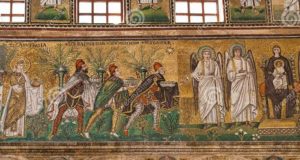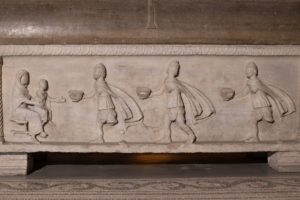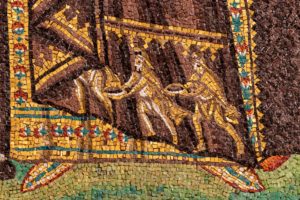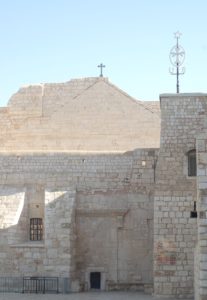Among all the buildings in the Holy Land, the Basilica of the Nativity in Bethlehem is perhaps the structure that has best withstood the test of time.
The first basilica was erected by Constantine and Helena in the early 4th century over the cave where Jesus was born. Less than two centuries later, it lay in ruins, possibly due to Samaritan uprisings. Emperor Justinian (r. 527-565), at the same time as he commissioned the construction of Hagia Sophia in Constantinople, initiated the restoration of the Basilica of Bethlehem. Since then, the church has endured numerous earthquakes, fires, and military conquests.
In 714, the armies of King Khusro I of Persia invaded Syria, Palestine, and Egypt. Unlike other wars between Rome and Persia, this was an all-out war of a religious character. As a result, the invaders adopted a policy of systematic destruction of Christian churches, which they saw as symbols of the emperor’s power. Miraculously, the Basilica of the Nativity was preserved.
In Bethlehem, it is said that the Persians, upon seeing a representation of the Magi dressed in the fashion of their country on the facade of the Church of the Nativity, decided to spare the temple from destruction. Although, at first glance, this oral tradition may sound like an urban legend, there is an ancient text confirming the events. In the 9th century, a synod convened in Jerusalem to put to rest the iconoclastic heresy. To justify the veneration of icons, the bishops of the synod recounted this miracle.
“The pagan Persians, upon reaching Bethlehem, beheld with astonishment the image of the Magi, stargazers, and fellow countrymen. Moved by respect and affection toward their ancestors; and venerating them as if they were alive, they spared the church. (Quoted by Vincent & Abel, p. 128).
The same text from the synod adds that the western facade of the Basilica – that is, above its monumental entrance gate – was adorned with mosaics depicting the Nativity of Christ – with the Virgin carrying her Son on her lap – and the Adoration of the Magi. To gain a more precise idea of this scene of the Adoration of the Magi, we must compare it with another building also erected by Emperor Justinian: the Basilica of Saint Apollinare in Classe, in Ravenna (northern Italy).

Saint Apollinare in Classe, Ravena (Italy): Mosaic of the Adoration of the Magi.
The north wall of the nave of San Apollinare still preserves a magnificent mosaic depicting the Virgin Mary seated on a throne, with the Child on her lap, surrounded by two pairs of angels in white garments. On the left, three men approach, dressed in brightly colored garments typical of Persia: a short tunic with tight trousers and a Phrygian cap. Following Eastern custom, they present their gifts to the Child-God with their hands wrapped in their cloaks.
In several sarcophagi from the same period, such as the one in the Church of Saint Vitale, also in Ravenna, the scene of the Adoration of the Magi is represented with the same details as in the mosaic.

Sarcophagus of the church of Saint Vitale, Ravena.
Source: Opera di Religione della Diocesi di Ravenna
The iconographic theme of the three Magi presenting their gifts became so popular that Empress Theodora had it depicted in the folds of her gown, as we can see in the Basilica of San Apollinare.

The three Magi in the lower fold of Empress Theodora’s gown. Church of San Apollinare, Ravenna.
Source: Opera di Religione della Diocesi di Ravenna
Today, the facade of the Justinian Basilica is partially obscured by the Armenian convent and the buttresses of the bell tower. Barely discernible are the remains of the majestic Justinian facade with its three monumental doors. Above them stretched the mosaic of the Adoration of the Magi, which led the Persian invaders to reconsider their plan to demolish the Basilica of the Nativity.
By Henri Gourinard

Facade of the Church of the Nativity.
